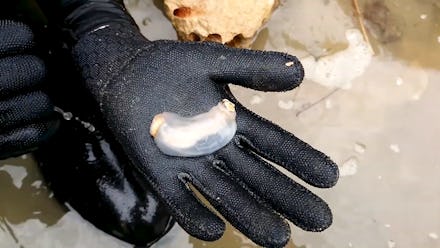Scientists are baffled by a weird mollusk that eats rocks and poops sand

It looks squishy, almost like a slug, and it fits in the palm of a hand like a big, fat grub. It might be kind of cute if you like tube things that look a bit like cloudy jelly. All right, so this newly discovered creature doesn't have much to go on in appearances, but its mysteries are tickling researchers who are eager to figure out its secrets. Scientists identified the mollusk as Lithoredo abatanica — an organism that is part of the mollusk group, making it technically related to clams and mussels. It's part of a family of species that have a shell so small that they look more like a worm. That is why this animal, as well as the rest in its family, are called 'shipworms,' known for burrowing into ships and piers to eat the wood. But this shipworm is different; this one chews into stone, passes it through its body, and excretes it as sand. And the reason for doing so is a complete puzzle.
"What's most remarkable about this is what we don't know," said Dan Distel, director of the Ocean Genome Legacy Center at Northeastern University. "The rock has no nutrients, there's nothing much in there that this animal could live on. So that tells us it's doing something else. And what that something else is should be very interesting."
In a video released by Northeastern University, Distel and his colleague, Dr. Reuben Shipway, eagerly discussed the discovery of L. abatanica and its habitat.
This stone-eating shipworm lives in the Philippines and was found about 3-5 kilometers along the Abatan River. According to Science Alert, the researchers first heard of this species in 2006, but they couldn't return to find it until recently. So far, the Abatan River is the only place in the world where it can be found. Due to its limited habitat, the scientists suggested this species should be considered for protection and conservation.
L. abatanica burrows deeply into limestone in the river, creating incredible tunnels and caverns to snugly fit its body into. An examination of the shipworm's anatomy revealed that it has developed different parts to accommodate for this, lacking features that the wood-eating shipworms have. It also has gills, lined with a yet-unknown bacteria, that goes along the entire length of its body, which the report noted as an unusual feature. The differences between this creature and other known shipworms were so numerous that the researchers were able to consider it a separate, new genus and species.
Their report also noted how the burrowing ability of this shipworm could have shaped the ecology of the river. The scientists observed how the abandoned tunnels made by L. abatanica became homes for other fish and invertebrates in the water. In fact, there were so many other water creatures that used the caverns as shelter that the research team believed the small shipworm could be a "dominant ecosystem engineer" with the ability to create flourishing habitats and gradually alter the shape of the river due to the sand it produces.
Studying L. abatanica isn't just important for scientists; it can be important for humans, too.
“One of the reasons we do this research is to discover novel drug compounds from these animals that could be used for humans,” Dr. Shipway explained to Motherboard. The bacteria that lines the shipworm's gills could be the next inspiration to produce better medicines. If that happens, then the significance of L. abatanica won't be limited to its home in the river — it'll be important to people, too.